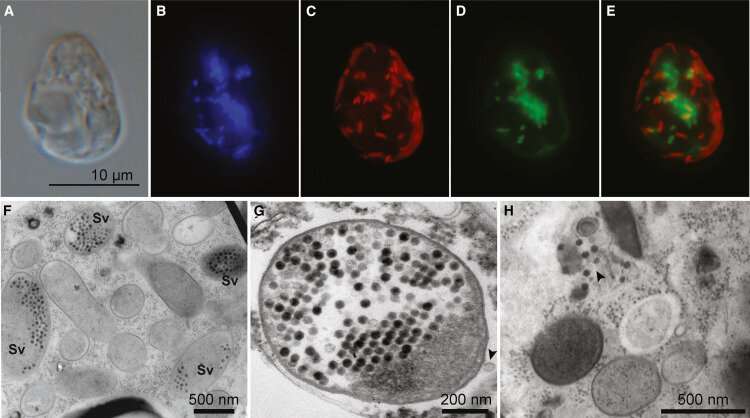Microscopy of Cryptomonas gyropyrenoidosa SAG 25.80 with bacterial endosymbionts. (A) DIC; (B) DAPI; (C) FISH-M. polyxenophila probe; (D) FISH-G. numerosa probe; (E) overlay of (C) and (D); (F) endosymbionts clustered in the host cytoplasm, including endosymbionts with virus-like particles (Sv); (G) endosymbiont with virus-like particles within the bacterial cytoplasm and attached to the bacterial cell’s surface (arrowhead); and (H) bacterial endosymbionts and a membrane-like structure (i.e., putative autolysosome vacuole) that potentially contains virus-like particles (arrowhead). Credit: Current Biology (2023). DOI: 10.1016/j.cub.2023.04.010
An international team of oceanographers, parasitologists and biologists has found that the single-celled alga Cryptomonas gyropyrenoidosa harbors seven genomes in its one cell. In their study, reported in the journal Current Biology, the group explored how one cell could hold more than one set of DNA and isolated seven of them in C. gyropyrenoidosa.
C. gyropyrenoidosa are a type of freshwater single-celled alga. Prior research efforts have shown that the algae harbor bacteria within their single cells and that some of the bacteria harbor viruses. In this new effort, the research team took at closer look at the common alga to learn more about its evolutionary history.
As the researchers note, finding cells with more than one set of DNA is not rare—most animals, for example, have two, nuclear DNA and mitochondrial DNA—the latter has separate DNA because mitochondria evolved from an ancient bacterium. Also, other studies have shown that dinoflagellates harbor a type of alga that in turn harbor six distinct genomes.
Study of C. gyropyrenoidosa showed that its first evolutionary stage was as a free-swimming predatory cell. Sometime later, it engulfed a complex plant cell, a type of red alga that gave it the ability to photosynthesize. And the nucleus of that red alga left behind gene remnants that still exist today. Because it was complex, that meant it left behind remnants of four genomes. Over time, C. gyropyrenoidosa was infected also by two types of bacteria that embedded their DNA into the alga cell. And one of those bacteria harbors a persistent virus, which has its own DNA. All told, that adds up to seven distinct genomes inside of one cell—a record, as far as the team knows.
The researchers also found that bacteria infected with a virus in C. gyropyrenoidosa, have spread more of their DNA in the cell than bacteria not infected by a virus. They also wonder why the virus has not killed off its host bacteria. They note that it is possible that the virus confers advantages that help the bacteria to persist in the cell.
More information: Emma E. George et al, A single cryptomonad cell harbors a complex community of organelles, bacteria, a phage, and selfish elements, Current Biology (2023). DOI: 10.1016/j.cub.2023.04.010
Journal information: Current Biology
© 2023 Science X Network
























